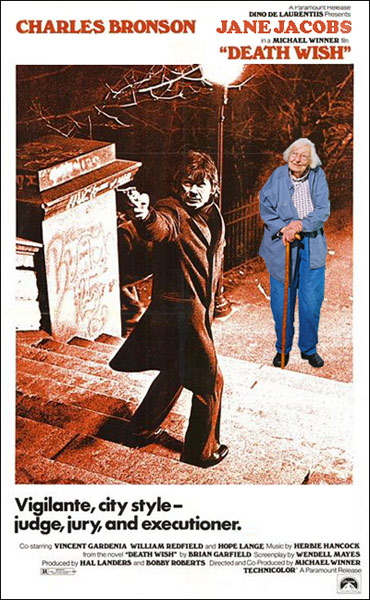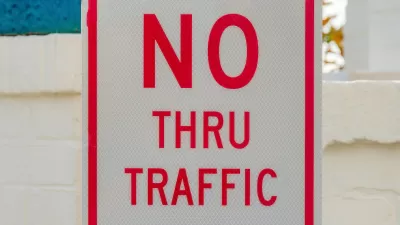City streets need only few things to make them safe, according to the famous urbanist Jane Jacobs. She says safe streets need people walking around, places for them to go, things for them to do and other people for them to interact with. Simple as that. But Jane forgot one more thing: a sock full of quarters.
City streets need only few things to make them safe, according to the famous urbanist Jane Jacobs. She says safe streets need people walking around, places for them to go, things for them to do and other people for them to interact with. Simple as that. But Jane forgot one more thing: a sock full of quarters.
This final piece is a critical element in maintaining the safety of a street or neighborhood. The antidote to crime and the fear it inspires is a community that asserts its own security. The social livelihood of streets and neighborhoods is what maintains safety and security. But in the absence of this social interaction, crime prevails. The fear of crime kills the street.
The sock full of quarters is just one weapon in the war against crime, but one that can be used quite effectively when the elements Jacobs writes about disappear. Paul Kersey, the main character of the classic American film series Death Wish, exhibits its effectiveness.
In the original 1974 film, Kersey is brought to life by the acclaimed actor Charles Bronson, who deftly portrays an urbanite unhinged after the brutal murder of his wife and the near-fatal rape of his daughter. With little faith left in his city and its ability to protect its citizens, Kersey turns to brute force. He stalks out into the night to reclaim the safety of his neighborhood and city through vigilante-style attacks on the criminals making his streets unsafe. It's a perfect example of citizen participation in the planning process – one man advocating for change and achieving it.

In her masterwork, "The Death and Life of Great American Cities", Jane Jacobs didn't exactly write about smashing people's heads with blunt objects. But she clearly understood its importance. It is the people who have the power to make change in their communities, Jacobs said. But they often don't realize that power is in their hands. Paul Kersey realized this power as he aimed his gun at the face of crime. Jacobs realized it as she wrote about the problems arising from short-sighted urban renewal projects. Each is a champion of creating better neighborhoods, and the work of both Kersey and Jacobs bolsters that of the other.
"Today barbarism has taken over many city streets, or people fear it has, which comes to much the same thing in the end," Jacobs wrote in her 1961 book. "It does not take many incidents of violence on a city street, or in a city district, to make people fear the streets. And as they fear them, they use them less, which makes the streets still more unsafe."
The violence Jacobs writes about can kill street life and ruin entire neighborhoods. This can be seen in many depressed inner cities across the country, where the misfortunes and missed opportunities of the nation's often neglected poor compound to push neighborhoods down a seemingly irreversible path towards self destruction. It becomes a positive feedback cycle, in which violence causes violence, and the presence of this violence only makes the neighborhood an even better place for yet more violence.
Bronson's character understood this as well. He saw this feedback loop forming firsthand and karate-chopped his community's downward spiral into submission. His anonymous vigilante justice brought a sense of change back into his city, and also a reminder that community-members are not powerless to control the fate of their streets. He made his neighborhood safer by fighting against violence, which was rampant and self-encouraging. He understood what Jacobs understood -- that cities need interaction and positive forces to steer them in the right direction.
"If we're not pioneers, what have we become?" Paul Kersey asks his son in an especially poignant moment of the five-part "Death Wish" series. "What do you call people who, when they're faced with a condition or fear, do nothing about it, they just run and hide?"
Well, Paul, you'd call those people cowards.
But those that actually do something to counteract this condition of fear are, today, what we'd call urbanists. These are people who care about their neighborhoods and about how to make them better. These are people who know that when cities have nobody to care for them, they waste away. These are people like Paul Kersey and Jane Jacobs. One may be fictional and the other real, but both have important lessons to teach about what it means to be part of a neighborhood.
They are both heroes of community -- people who are fighting for a better existence. Not only do cities and their neighborhoods need people and interaction, they need people who are willing to take action – drastic action, if necessary – to ensure the safety and livability of their communities. Without them, the fear of a terrible existence may become reality.

Planetizen Federal Action Tracker
A weekly monitor of how Trump’s orders and actions are impacting planners and planning in America.

Map: Where Senate Republicans Want to Sell Your Public Lands
For public land advocates, the Senate Republicans’ proposal to sell millions of acres of public land in the West is “the biggest fight of their careers.”

Restaurant Patios Were a Pandemic Win — Why Were They so Hard to Keep?
Social distancing requirements and changes in travel patterns prompted cities to pilot new uses for street and sidewalk space. Then it got complicated.

Platform Pilsner: Vancouver Transit Agency Releases... a Beer?
TransLink will receive a portion of every sale of the four-pack.

Toronto Weighs Cheaper Transit, Parking Hikes for Major Events
Special event rates would take effect during large festivals, sports games and concerts to ‘discourage driving, manage congestion and free up space for transit.”

Berlin to Consider Car-Free Zone Larger Than Manhattan
The area bound by the 22-mile Ringbahn would still allow 12 uses of a private automobile per year per person, and several other exemptions.
Urban Design for Planners 1: Software Tools
This six-course series explores essential urban design concepts using open source software and equips planners with the tools they need to participate fully in the urban design process.
Planning for Universal Design
Learn the tools for implementing Universal Design in planning regulations.
Heyer Gruel & Associates PA
JM Goldson LLC
Custer County Colorado
City of Camden Redevelopment Agency
City of Astoria
Transportation Research & Education Center (TREC) at Portland State University
Camden Redevelopment Agency
City of Claremont
Municipality of Princeton (NJ)




























